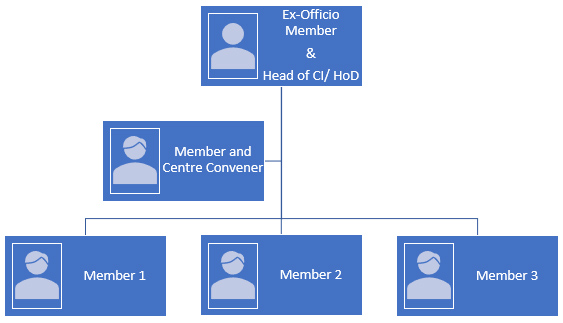Centre for Excellence
EMPOWERING INNOVATION THROUGH THE CENTRE OF EXCELLENCE
The Nexus of Centre of Excellence, Department-Level Innovation Centers, and DIRCs
In the dynamic landscape of today's world, innovation stands as the cornerstone of progress and societal advancement. Educational institutions, recognizing the critical role of innovation in shaping the future, have established Centers of Excellence (CoEs) as dedicated hubs for fostering cutting-edge research, technological breakthroughs, and creative problem-solving. These CoEs, often embedded within specific departments, serve as catalysts for innovation, nurturing collaboration, and providing resources to support ground-breaking initiatives.
Department-Level Innovation Centers: Driving Innovation at the Departmental Level
Department-level Centre for Innovations (CFIs) plays a crucial role within the broader CoE framework. These CFIs, embedded within specific academic departments, act as focal points for innovation within their respective disciplines. They provide a platform for faculty, students, and researchers to engage in interdisciplinary collaborations, explore new ideas and develop innovative solutions to real-world challenges.
DIRCs: Overseeing and Guiding Innovation at the Departmental Level
The Departmental Innovation Research Committee (DIRC) serves as the governing body of CFIs, responsible for overseeing their operations and strategic direction. This committee, typically composed of senior faculty members, industry experts, and representatives from the student body, provides guidance and support to CFI initiatives, ensuring that they align with the overall goals of the CoE and the department.
Key Functions of DIRCs: Nurturing Innovation from Conception to Implementation
DIRCs play a multifaceted role in fostering innovation within their respective departments:
1. Identifying and Cultivating Innovation Opportunities: DIRCs actively seek out and promote innovative research projects, providing support and resources to faculty and students who are pursuing ground-breaking ideas.
2. Enhancing Interdisciplinary Collaboration and Knowledge Exchange: DIRCs facilitate collaboration between faculty, students, and researchers from diverse disciplines, encouraging cross-pollination of ideas and knowledge sharing.
3. Providing Resources and Infrastructure for Innovation: DIRCs secure access to necessary resources, such as specialized equipment, software, and funding, to support innovative research and development endeavours.
4. Strengthening Industry-Academia Linkages: DIRCs actively engage with industry partners to promote knowledge exchange, technology transfer, and collaborative research projects.
5. Cultivating a Culture of Innovation: DIRCs foster a culture of innovation within their departments, encouraging creative thinking, problem-solving, and risk-taking among faculty and students.
DIRCs to the Overall Success of CoEs: Driving Innovation on a Broader Scale
DIRCs play a vital role in the overall success of CoEs by:
1. Strengthening Departmental Innovation Capabilities: DIRCs enhance the innovation capacity of their respective departments, providing a dedicated space and resources for nurturing creative ideas and developing innovative solutions.
2. Expanding Interdisciplinary Collaboration: DIRCs facilitate cross-disciplinary collaboration, bringing together researchers from diverse fields to tackle complex challenges and generate novel solutions.
3. Bridging the Gap between Academia and Industry: DIRCs promote knowledge exchange and collaboration between academia and industry, fostering the transfer of technology and the development of industry-relevant innovations.
4. Nurturing a Culture of Innovation: DIRCs cultivate a culture of innovation within their departments, encouraging faculty and students to embrace creativity, problem-solving, and risk-taking.
5. Contributing to the Broader CoE Ecosystem: DIRCs contribute to the overall success of the CoE by feeding innovative ideas and advancements into the broader CoE framework.
Centres of Excellence, empowered by department-level innovation centres and their governing bodies, DIRCs, serve as powerful engines of innovation within educational institutions. DIRCs, embedded within specific departments, provide a focused platform for nurturing ground-breaking ideas, fostering interdisciplinary collaboration, and bridging the gap between academia and industry. Their contributions to the overall success of CoEs are undeniable, as they play a pivotal role in shaping a culture of innovation that drives progress and paves the way for future success.
The centre names identified under different streams are:
Department- Specific Name of Centre for Innovations
1. CE - THE CENTRE FOR INNOVATIONS IN SUSTAINABLE MATERIALS AND WASTE MANAGEMENT (CISMWM)
2. CSE - CENTRE OF INNOVATION IN ADVANCED COMPUTATIONS AND SYSTEMS (CIACS)
3. ECE - CENTRE FOR INNOVATIONS IN INTEGRATED ELECTRONICS AND COMMUNICATION [CIIEC]
4. EEE - CENTRE FOR INNOVATION IN CLEAN ENERGY (CICE)
5. ME - CENTRE OF INNOVATION IN COMPUTATIONAL MECHANICS AND ADVANCED MATERIALS (CICMAM)
6. MBA - CENTRE FOR INNOVATION AND ENTREPRENEURSHIP (CIE)
7. MCA - CENTER FOR INNOVATION IN COMPUTATIONAL AUGMENTATION AND SYSTEMS [CICAS]
8. SH - CENTRE_FOR_INNOVATIONS_IN_BASIC AND APPLIED SCIENCE (CIBAS)
9. NASB - CENTER FOR INNOVATION IN MARINE AND OFFSHORE TECHNOLOGY [CIMOT]
The policy may be amended from time to time depending on the specific needs of the work and other factors of the concerned centres with the consent of the Chairman (ORI) the same will be regularly reviewed and updates will be incorporated by the Departmental Innovation and Research Committee and considered for revision if needed.
